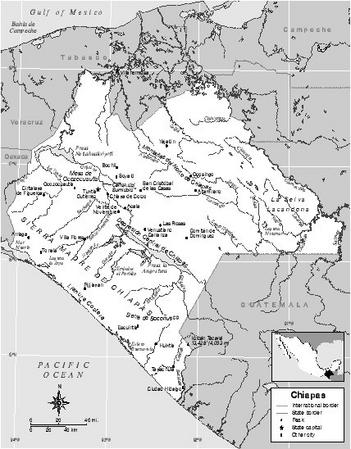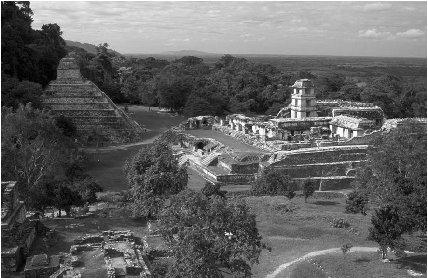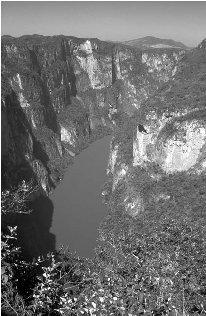Chiapas

Pronunciation: chee-AH-pahs.
Origin of state name: The name of Chiapas is taken from the ancient city of Chiapan, which in Náhuatl means the place where the chia (a kind of sage) grows.
Capital: Tuxtla Gutiérrez.
Entered country: 1841.
Coat of Arms: The coat of arms was initially the emblem of Ciudad Real, now known as San Cristóbal de las Casas, a colonial city located one and one-half hours away from the capital of Tuxlta Gutiérrez. It was founded in 1535 by the Spaniards. The lions, castle, and crown represent the power and authority held by King Carlos V (1500 – 1558) of Spain.
Holidays: Año Nuevo (New Year's Day—January 1); Día de la Constitución (Constitution Day—February 5); Benito Juárez's birthday (March 21); Primero de Mayo (Labor Day—May 1); Revolution Day, 1910 (November 20); and Navidad (Christmas—December 25).
Flag: There is no official flag.
Time: 6 AM = noon Greenwich Mean Time (GMT).
1 Location and Size
Chiapas is situated in southern Mexico. It has an area of 73,724 square kilometers (28,465 square miles). It is slightly smaller than the US state of South Carolina. Chiapas is bordered on the north by the Mexican state of Tabasco, on the south by the Pacific Ocean, on the east by the Central American nation of Guatemala, and on the west by the Mexican states of Oaxaca and Veracruz. Chiapas has 111 municipalities. Its capital, Tuxtla Gutiérrez, lies near the center of the state.
Chiapas has a coastal plain along the Pacific Ocean to the south. In the north, the coastal plain that begins in Tabasco extends into Chiapas. The Sierra Madre is a chain of high mountains that run from the northwest to the southeast. The highest peak is the Tacaná volcano (4,093 meters/13,428 feet in elevation), which lies on the border with Guatemala. The Grijalva River flows northwest through the center of the state until it empties into the Bahía de Campeche. There are three major dams along the Grijalva. The spectacular Cañon del Sumidero (Sumidero Canyon) was formed by the Grijalva River. A high plateau, the highest region in the state, lies in the center of Chiapas.
2 Climate
Temperatures are fairly constant year round, with variation depending on elevation. The north is dry with little rainfall, but the southern part of the state is more humid. The average temperature is 20° c (68° f ), but temperatures may reach as high as 40° c (104° f ) and as low as 0° c (32° f ).
3 Plants and Animals
Orchids and bromeliads (plants of the pineapple family) are native to the tropical areas of the state. Mangrove trees are also native. The forest area has jaguars, flying squirrels, monkeys, white-tailed deer, tapirs, toucans, and parrots. At higher elevations there are hardwood trees such as mahogany and cedar. Crocodiles and hundreds of species of birds live along the Pacific coast.
4 Environmental Protection
In the 1990s, Chiapas began to protect and preserve its cloud forests (forest at high elevations) and coastal areas. The El Triunfo Biosphere Reserve is located in the south in the Sierra Madres. It ranks as one of the most biologically diverse places on the planet and encompasses approximately 300,000 acres.
La Encrucijada Biosphere Reserve is located in the Pacific coastal area of Chiapas and covers 357,824 acres. This reserve offers the tallest mangroves on the Pacific coast and healthy numbers of crocodiles, jaguars, raccoons, and iguanas.
5 Population, Ethnic Groups, Languages
Chiapas had a total population of 3,920,892 in 2000; of the total, 1,941,880 were men and 1,979,012 were women. The population density was 53 people per square kilometer (137 people per square mile). In 2000, the capital, Tuxtla Gutiérrez, had a population of 433,544. About 25% of the population speaks one of the Mayan languages. Chiapas has the third largest population of indigenous language speakers (after the Mexican states of Yucatán and Oaxaca).
6 Religions
According to the 2000 census, 53% of the population, or 2.1 million people, were Roman Catholic; 12%, or 457,736 people, were Protestant. That year there were also 173,772 Seventh-Day Adventists, 82,646 Jehovah's Witnesses, and nearly 470,000 people who reported no religion.
7 Transportation
Most of the state's 7,000 kilometers (4,375 miles) of highways are paved. Many rural areas are accessible only by rough dirt roads.
Tuxtla Gutiérrez-Llano San Juan Airport provides international flights to and from Chiapas.
8 History
Human presence in Chiapas dates as far back as 600 A . D . Located in the heart of the region of Mayan influence, Chiapas was home to some of the most important Mayan ceremonial centers, like Palenque , Bonampak , Yaxchilán, and Lacanjá. Chiapa Indians eventually conquered

When the Spaniards arrived, the Chiapa and a number of other indigenous groups inhabited different parts of the Chiapas region. After five years of fierce fighting between the Spanish and the indigenous peoples (1522–1528), the Spanish conquistadores (conquerors) dominated enough land to found a city, Villa Real, known today as San Cristóbal. As part of Guatemala in the 17th century, the indigenous people in Chiapas continued to stage revolts against Spanish occupation. In 1712, several groups waged a bloody war on the Spanish colonizers, fighting against slavery and other forms of oppression.
Chiapas was highly identified with Spanish colonial rule and connected to its southern neighbor, Guatemala. So Chiapas did not immediately join the drive for Mexico's independence. Catholic priest Matías Antonio de Córdoba declared independence from Spanish rule in 1821. A plebiscite (vote) in 1824 ratified Chiapas's union with Mexico. A new state constitution was created in 1826. Despite Guatemala's protest, Chiapas was fully incorporated into Mexico in 1841.
Conflicts between the colonial landowners and the indigenous people continued throughout the 19th century. The Mexican Revolution, which started in 1910, barely extended to Chiapas. Nevertheless, large landowners in Chiapas actively participated in the debates that surrounded the conflicts. Many revolutionary leaders demanded reform of the way farm land was distributed and used. Indigenous groups did not join the revolution in favor of land reform demands.
When the revolution came to an end, the Institutional Revolutionary Party (PRI) emerged as the only important political party. An alliance between PRI leaders and large Chiapas landowners prevented the land reforms from reaching Chiapas and benefiting the indigenous communities. Chiapas remained one of the poorest states, with one of the largest indigenous populations. In Chiapas, unlike other states, the indigenous population remained autonomous and experienced little interaction with the local government, controlled primarily by the landed state elite.
An indigenous revolt triggered by the enactment of the North American Free Trade Agreement (NAFTA), a trade agreement between Mexico, the United States, and Canada, caused worldwide controversy in 1994. The indigenous armed revolt, initiated on January 1, 1994, combined opposition to globalization, rejection of free trade, and indigenous demands for land, respect, and political and cultural autonomy. The Zapatista Army of National Liberation (EZLN) was led by a popular revolutionary leader known as Marcos and by several indigenous leaders. Although the movement successfully brought indigenous demands and concerns over their values and cultural traditions to the forefront of the international debate, the movements' ambitious goals of evolving into a new national revolutionary force that could topple the PRI government eventually failed when the rest of Mexico experienced a process of democratic consolidation starting in the mid 1990s and ending with the PRI defeat in the 2000 presidential elections.
In January 2003, about 20,000 masked militants from the EZLN moved into San Cristóbal. They carried machetes and sticks and lit bonfires in the center of the city to protest government actions. The

Chiapas was home to important Mayan ceremonial centers, like this one at Palenque.
9 State and Local Government
The state governor is the most influential and powerful political figure. Elected for a nonrenewable six-year term, the governor is the chief executive. A ministerial cabinet is appointed by and accountable to the governor. Formal separation of power and check-and-balance provisions also provide for a unicameral (one chamber) legislature. The state congress is comprised of forty deputies. Twenty-four are elected in single member districts and sixteen are elected at large for proportional representation. All deputies serve for nonrenewable three-year terms.
Comprised of 116 municipalities, Chiapas is one of the most ethnically diverse states in Mexico. Local governments have strong power to determine their own rules, especially in the independent indigenous communities. Political conflicts resulting from the opposition of federal authorities to increased power by indigenous communities regularly force courts to assess the limits of local authorities in exercising power.

The spectacular Cañon del Sumidero (Sumidero Canyon) was formed by the Grijalva River.
10 Political Parties
The three main political parties in all of Mexico are the Institutional Revolutionary Party (PRI), the National Action Party (PAN), and Party of the Democratic Revolution (PRD). The PRI, in association with large traditional land-owning families, exercised political control of the state throughout most of the 20th century. The 1994 indigenous revolt propelled the Zapatista Army of National Liberation (EZLN) to the forefront of national and state politics. The EZLN rejects electoral politics as a legitimate means of reaching power. This helped the two national opposition parties, the conservative PAN and the leftist PRD, to gain ground and capitalize on discontent against the PRI. Former PRI leader, Pablo Salazar, won the 2000 gubernatorial election with support from the PAN and PRD.
11 Judicial System
The Supreme Tribunal of Justice is the highest court in Chiapas. Its members are appointed by a two-thirds majority in the legislature from a three-person list presented by the governor. Supreme Tribunal justices serve nonrenewable seven-year terms. In addition, the Chiapas judicial system includes an electoral tribunal, a civil service tribunal, and local and indigenous courts. There are additional complexities resulting from Chiapas's strong indigenous presence. The indigenous communities use alternative courts and legal systems.
12 Economy
Crude oil production, manufacturing, and small-scale agriculture are important segments of the economy. Chiapas is a major producer of coffee for export.
13 Industry
In 2002, the state's first maquiladora (assembly plant) opened in San Cristóbal, to manufacture sweaters and T-shirts for sale in the United States. Overall there is little industry in Chiapas.
14 Labor
Many workers in Chiapas live in homes with no electricity or running water. They are among the lowest paid workers in Mexico. The US Bureau of Labor Statistics reported that Mexican workers saw their wages increase 17%, from $2.09 per hour in 1999 to $2.46 per hour in 2000. (The average US worker earned $19.86 per hour in 2000.) After one year, workers are entitled by law to six days paid vacation.
15 Agriculture
Coffee is the most valuable agricultural product; about 60% of Mexico's total coffee output comes from Chiapas. Chiapas ranks second among the Mexican states in the production of cacao, the product used to make chocolate.
Other crops grown in Chiapas include sugarcane, cotton, bananas, and other fruits. These are grown especially in the lowland regions near the Pacific coast. Some land is devoted to pasture for livestock. There are nearly a million chickens, turkey, and ducks raised by farmers each year; milk is another major product produced in the state.
16 Natural Resources
Chiapas has rich natural resources, including the watershed of the Grijalva River, tropical rainforests, oil, gas, uranium, iron, aluminum, copper, and amber. One-third of Mexico's crude oil is produced by Chiapas.
Lumber production more than doubled in the 1990s. About 80% of the lumber produced is pine. Fishing for shrimp, mullet, and sea bass is carried out in the coastal Pacific Ocean waters.
17 Energy and Power
Electricity in the state is produced by seven hydroelectric plants and four thermal plants. Nearly 25% of all of the country's electricity is generated in Chiapas. A 210-megawatt hydroelectric plant was due to begin operation at Copainalá in 2008. Mexico's existing natural gas reserves are located primarily in the southwestern states of Tabasco and Chiapas.
18 Health
There are 42 general hospitals, 1,510 outpatient centers, and 83 surgical centers in various cities.
Most of the Mexican population is covered under a government health plan. The IMSS (Instituto Mexicano de Seguro Social ) covers the general population. The ISSSTE (Instituto de Seguridad y Servicios Sociales de Trabajadores del Estado) covers state workers.
Government health care services are not always available in zones where there is conflict between the government and rebels.
19 Housing
Housing in Chiapas is of generally poor quality, with almost half of the available housing in need of replacement or significant improvements. An estimated two-thirds of houses have dirt floors. About one-third of all homes, mostly in rural areas, do not have electricity.
20 Education
The system of public education was first started by President Benito Juárez (1806–1872) in 1867. Public education in Mexico is free for students from ages six to sixteen. Many students elect to go to private schools. The thirty-one states of Mexico all have at least one state university. The State University of Chiapas (UNACH) is in Tapachula.
Children in the small Mayan communities in rural areas may attend local schools specifically structured to preserve Mayan language and culture.
21 Arts
The state of Chiapas hosts at least six major theaters including El Teatro de Bellas Artes and Teatro de la Ciudad Emilio Rabasa. The Cultural Center of Chiapas Jaime Sabines, named for the well-known poet, hosts art exhibits and performances of all types. There is also a chapter of the French cultural society Alianza Francesa in the capital city of Tuxtla Gutiérrez. The Coro de Cámara Canto Nuevo (Choir of New Song) was founded in 2002.
22 Libraries and Museums
The state of Chiapas has 332 branches of the national library. There are about fifty museums. In the capital, Tuxla Gutiérrez, there is a botanical gardens and a museum of paleontology (the study of fossils).
23 Media
The capital, Tuxtla Gutiérrez, has three daily newspapers: Cuarto Poder, Este Sur, and La República en Chiapas. Tapachula has two daily newspapers: El Orbe and Noticias de Chiapas.
Television networks Televisa, TV Azteca, and Polytechnic broadcast in the state. There is limited cable service in the cities. There are over twenty radio stations broadcasting in Chiapas.
24 Tourism, Travel, and Recreation
Tuxtla Gutiérrez is the home of the 17th-century Cathedral of San Marcos. The church tower has marching statues of the twelve apostles, which move to mark every hour, accompanied by forty-eight church bells. One of the best zoos in the country, the Miguel Alvarez del Toro Zoo in Tuxtla Gutiérrez, has an interesting collection of native animals.
25 Sports
The soccer team, Jaguares, from the city of Tuxtla Gutiérrez plays in the Victor Manuel Reyna stadium, which holds 25,000 people.
26 Famous People
Emilio Rabasa (1856–1930), from Ocozocoautla, who became governor and ambassador to the United States, was a prominent legal scholar. Poet Jaime Sabines (1926–1999) was born in Tuxtla Gutiérrez. The rebels of the Zapatista Army of National Liberation (EZLN) take their name from Emiliano Zapata (1879–1919), born in Morelos , leader of a revolution in the early 20th century. Miguel Alvarez del Toro (1917–1996) was a prominent naturalist; the zoo in Tuxtla Gutiérrez is named in his honor.
27 Bibliography
Books
Carew-Miller, Anna. Famous People of Mexico. Philadelphia: Mason Crest Publishers, 2003.
DeAngelis, Gina. Mexico. Mankato, MN: Blue Earth Books, 2003.
Jacobson, Marcey. The Burden of Time: Photographs from the Highlands of Chiapas. Stanford, CA: Stanford University Press, 2001.
Ortiz, Teresa. Never Again a World Without Us : Voices of Mayan Women in Chiapas, Mexico. Washington, DC: EPICA, 2001.
Supples, Kevin. Mexico. Washington, DC: National Geographic Society, 2002.
Web Sites
Mexico for Kids. http://www.elbalero.gob.mx/index_kids.html (accessed on June 11, 2004).
racheal h.
I recommend revising your information. After the 1917 constitutional change in Mexico, many people in Chiapas obtained land as stipulated in the land reform.
I heard that there is a Centra (center to treat addictions, I am not sure about the spelling)can you give me more info about it?
Also, if I was to move down there, would it be easy for a bilingual person English/Spanish to obtain a job and in what field? I have knowledge on the use of computers, I also graduated in Mexico in the early 80's as a primary school teacher and have experience in the tourist industry. My husband is a framer/roofer and is bilingual in French and English.
Thank you.
Susana